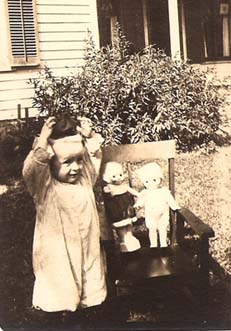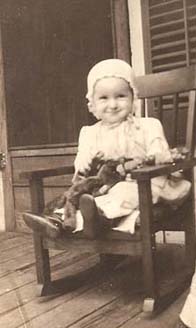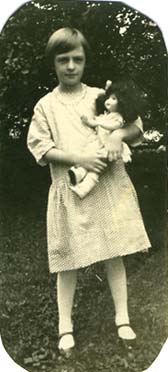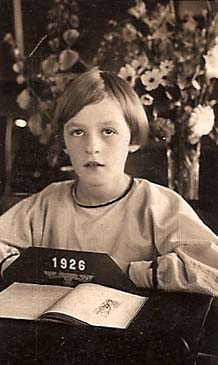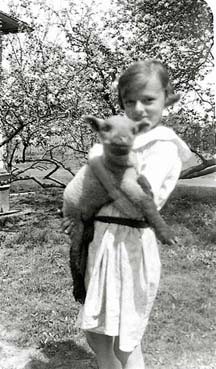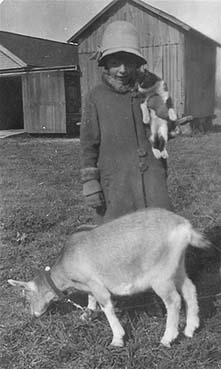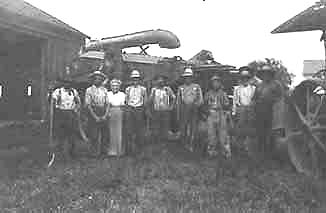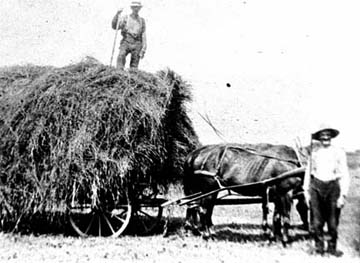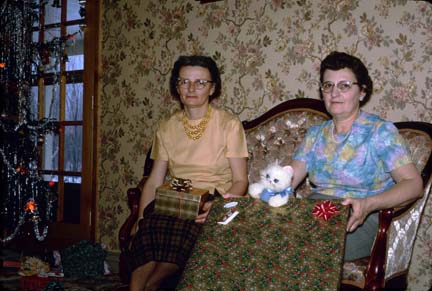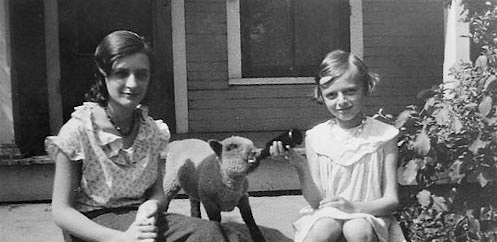
Life on Boston Road, Strongsville, Ohio
Written by Maxine (Howard) Wise (1918-1983) who grew up on Boston Road
|
|
|
It was a beautiful summer afternoon, probably 1921 or 1922, when I ran and skipped along beside my Grandma Hoyt going to the bread wagon. It was a small enclosed truck painted yellow with a big red star on the side. The driver would stop at anyone's house where the bread card, a yellow card with a red star, was displayed in the window of the home. The driver got out and opened the double doors in the back. There were drawers to be pulled out with all kinds of baked goodies. It was the Star Bakery from Cleveland. I can remember Grandma usually wore a big wrap around apron that tied at the waist. She was to me a beautiful woman in her fifties. It must have been a happy experience for I remember it so well.
|
|
|
One day in 1922, Dr. Perry came from Berea with his little black bag and he placed it on my play table‑‑the black stand that Dad had made to hold bathtub, etc. for Mother when I was a baby. Later that day Grandma told me that bag had held my darling sister he brought to me. I felt much better about it then, even though I could not use my table all day.
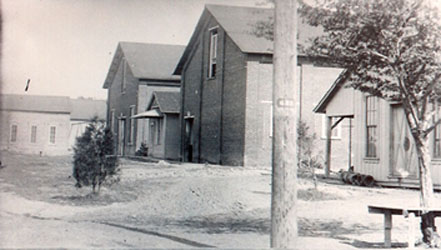
Standard Oil Pumping Station, Boston Road
Boston Road was a mud road. We did not have horses, but Dad somehow managed to get through. Cars were higher off the ground then, and they put chains on the back wheels in muddy weather. I remember Dad, Rolla Ward, Kinches, and Norb Mellar hauling cinders from the Standard Oil Pumping Station at the corner of Boston and Prospect Roads. As the station used coal‑fired steam boilers to pump oil in the lines, there were plenty of cinders from the burned coal. The lines ran from east to west in Ohio past our house on the south side of the road. Dad drove one of Ward's teams hauling cinders on the road. I can see him yet standing in the wagon, so young and handsome. Ward's had two beautiful teams of horses. The cinders made the road passable year round as far west as Beebetown Corners. As for the Pumping Station, it was a busy place. They had a small amount of special fire equipment, due to their oil business, and the manager was kind and always took it to a fire in the neighborhood and helped as best he could, so I have been told by Mother and Dad. It employed several people - engineers, firemen, etc. They all had "line walks," men who walked along the road daily watching for oil leaks in the lines. At the western end of Boston Road where it forks, they walked straight ahead through the field and on. At 6:00 am, noon, and 6:00 pm the pump station whistle blew. It could be heard for several miles around. Farmers knew it was time to come in from the fields.
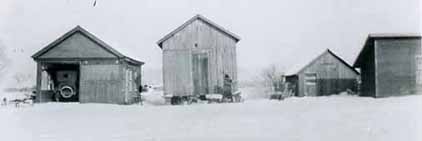
1915 Maxwell in garage. Originally the garage was a frame house built in the
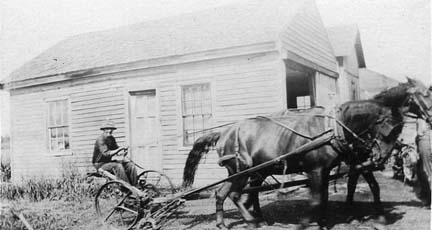
George Howard in front of original house, built ca. 1850
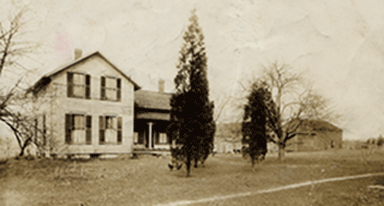
House built @1875 at 21926 Boston Rd.
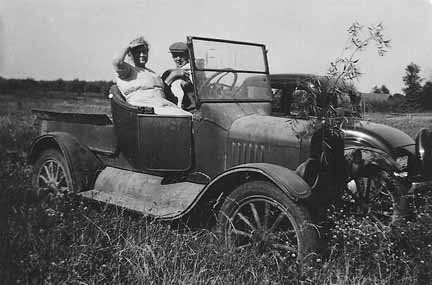
Model T Ford Truck and Roadster - Ethel & Dewitt Howard
There was an interurban electric car that ran from Cleveland to Bucyrus, Ohio, which ran along Prospect and stopped at the Pumping Station corner. It would run through the woods in back of Lockwoods and come out later on Substation Road. They were bigger than city streetcars and had velvet seats. Sometimes Mother, Arlene, and I would walk to the Pumping Station corner and take the car to Medina to shop. Grandpa Hoyt used it all the time to go to Cleveland to get his train as long as he worked. There was a little building on the northeast corner of Prospect and Boston Roads with a couple of built‑in benches where you could wait out of the weather until you heard the clanking of the streetcar. By the way, I remember the school kids waiting there for the school bus. The bus did not go from Prospect to Wooster Pike (as Pearl Road was called) because of the "terrible," unpaved, rutted hill. Those kids walked to Prospect Corner, as well as those who lived in the row houses in back of the Pumping Station. These houses were built by the Pumping Station for their employees and families. There also was a wooden platform near the track where farmers from around brought ten gallon milk cans full of fresh milk to ship to Cleveland. Then their empty cans were left there. I think they timed it so as to get there just before the car arrived. I remember Mr. Schnell going by with his team and wagon with milk cans at a certain time. It was a sad day for Grandpa, although he had retired from the railroad by then, when the streetcar went out of business. Lots of older people had depended on it. Dad was always willing to take Grandpa wherever he wanted to go. Grandpa never learned to drive; although I had heard Dad urge him to do so.
When I was little there was a grocery store in Berea, Siodla's, where you could call in an order, and one day a week they delivered in the country.
One day a week an old man from Cleveland came out with the fish wagon. He blew a tin horn as he came along. It was a very different sound. We would take out a pan and select the fresh fish we wanted. He scaled and dressed it there in the wagon. The horse‑drawn wagon was filled with crushed ice and full of fish. I heard he spent the night and bedded the horses at a farm home further on. Then he went back to Cleveland the next day. It was usually almost suppertime when he got to our house. Certain times of the year, he might have some crates of fresh fruit. I remember pineapple and bananas. Mother appreciated this as it was hard to get fresh fruit like that without going to Berea. I do not remember him coming in the winter at all.
I remember once in awhile gypsies would come along. They had big cars. I never remember the wagons as my parents did. They would stop by‑‑sometimes to buy a chicken or tell our fortune for money.
Occasionally a tramp would come by and ask for a drink or something to eat. Mother was always glad when Grandpa or Dad were at home.
There would also be the "Paper Rag Man." He came in an old truck, going along the road and calling out to buy scrap, etc.
I looked forward to Saturday evening in the summer. We would go to Berea for the band concert and to shop. There was a bandstand in the Triangle. Home talent would give a concert. The stores were all open. It seems like we often congregated at the A & P store as Herbert Garman was the manager. Sometimes we would stop at Aunt Alta's in Berea, too. Quite often we found Aunt Alta and Grandma Howard on the street. I remember going to the drug store, sitting at old fashioned ice cream parlor tables, and having ice cream in a dish with Grandma Howard. Dad would sometimes get a haircut Saturday evening.
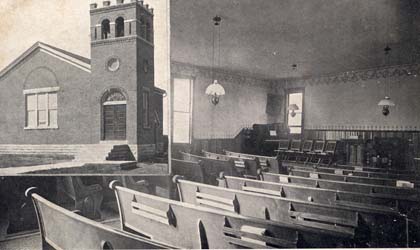
Beebetown Baptist Church
Mother would take us to Sunday School at the Beebetown Baptist Church. Sometimes we stayed for church. Dad usually drove us up. If he was unable to get us we would walk home.
Once a year a Sunday evening in June was set aside for a Children's Day program. It seems as soon as school was out we started to practice. Maybe a little skit, some recitations, and special music. Mother would walk up and back for practice with us. We never went alone. Dad would go Sunday evening for the service. I have seen the church full‑‑chairs in back and in the aisles. It would be decorated with garden flowers. The mothers usually did this. Mother helped with the program and Bessie McConney had charge of the music when we were little.
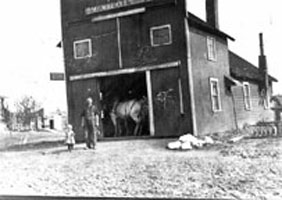
Jake Smith's Blacksmith Shop
Jake Smith had a blacksmith shop on the southeast corner of Marks and Boston. I remember seeing the fire, etc. in the shop as there were still horses to be shod. If it was at all warm, the door was open. Later years he worked as a mechanic on cars.
Down on Marks Road, north at the railroad crossing, was a grocery store and mill. I can remember going there when Uncle Ray was running them. It seems to me he was handling both businesses alone. If he wasn't in the store we would go out to the mill.
Every summer they had the Beebetown Reunion. People who had lived there were sent a card. At one time Mother had the book with the list of names. They would put up a big tent in back of the church. There was a pot luck dinner. Ice tea was furnished. All water had to be carried from Fred Mayer's across the road as there was no well at the church. I understand this was a continuation of the Beebetown School Reunion originally held on the school grounds. The old school house was on the northeast corner of Marks and Boston. Dad remodeled the school into a house. I remember Dad and Rolla Ward going to Berea for the tent. I think it was loaned by an undertaker. Rolla would haul it in his farm truck. There was usually a good turnout. I cannot remember the exact number, but it was a big day for the kids.
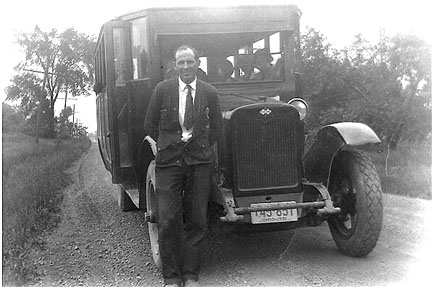
Milo Smith. School Bus on Boston Rd. 1931
I started school riding a horse drawn kid wagon driven by Ellsworth Poots. It would go from Prospect Road to Beebetown Corners. Kids from south, west, and north of the corner walked to there to get the Strongsville bus. They could always wait in the Blacksmith Shop on cold days. I remember there were not many kids from one direction in those days. Then I got on as the kid wagon went back to Prospect corner where a big old bus with side curtains took us to school. The seats went long ways along the bus - one on each side. We picked up the kids on Prospect, too. This was my first year of school. The second year the bus went to Beebetown Corners. The year I started was the first year of consolidated schools‑‑taking everyone from every direction to school at the center of Strongsville. By the way, my first six grades of school were spent in the old front building, and we had to go to outside toilets in back of what was then the high school building. We carried our lunches. I do not remember a cafeteria until later. The milkman would come through the building and we could order milk.
There also was the Ladies' Aid of the church. They held a bazaar almost every fall when I was small. It was usually held at Floyd Sherman's and Arthur Clement's home. They all lived in the same home at the southwest corner of Marks and Boston. There was a fancywork booth, an apron booth, and usually one of home baked goods and candy. Mother had charge of the fancywork booth with Bessie Ward as long as Bessie lived. They had a pot luck supper. Men would go, too. They had to take us in those days. What fun! The kids usually played upstairs. It was simply a neighborhood affair. Mrs. Fred Mayer always had charge of aprons. I cannot remember the others, but everyone helped.
Harley Fuller had get‑togethers, too; but I cannot remember what they were for. I think they had to do with Sunday School.
We had an ice cream social in our front yard once. So much fun! Then in later years Dr. and Ruth Fuller had several in the summer evenings. Ruth Fuller started a girls' Campfire group when I was in my teens. Many good times were had. It was the first time I ever ate marshmallows toasted on graham crackers with a piece of Hershey bar.
Summer evenings we would sit on our front porch and steps. Harley Lockwood's lane for cows ran back of Bert Lockwood's plowed land across the road, running east and west. The cows would go back to the woods, after being milked at his barn on Substation Road. We called it Lockwood's Road then. He always had a cow bell on one. Such a pleasant sound. So quiet in those days. Sometimes in the evening Dad, Arlene, and I would play hide and seek in Bert Lockwood's corn field across the road. Some evenings we would see Joe Mellar, Sr. walking down the road. He and Grandpa Hoyt would sit and visit‑‑especially about Cleveland as they both had lived there.
Dad built a new chicken coop north of the house. Mother was in hopes the chickens would stay away from the house as they were never fenced in. The first summer we were allowed to have it for a play house. What an event!
We also liked to coast down the little hill from the back door to the outhouse in our coaster wagon. There was a concrete path. In the back yard was a little coal shed Dad had built to put kitchen fuel in. It was a little northwest of the well. The furnace coal was dumped in a corner under our north bedroom window and carried down or thrown down through the cellar window. There was always wood piled in the back yard. Dad spent many days cutting wood. They had to figure when the ground was dry or frozen to get the fuel in.
We never wanted for anything during the Great Depression. Of course, I am sure Mother and Dad did a lot of figuring. We always had a big garden and plenty of home‑grown fruit. Mother canned fruits‑‑pears, plums, blackberries, etc. We had a few peach trees, not many. Dad had built an apple bin on the west wall of the cellar. We always had lots of apples. Underneath that was a potato bin. Mother never canned vegetable. They bought these. I remember nice squash that lasted way into winter. She baked them in the cook stove oven. Were they ever good!
Wards always raised strawberries. After the big picking season, they would let us go in and pick. In the meantime we had scoured our fields for wild berries. Mother made them all into jam. We always went in the evening and Dad went too. Oh yes, the elderberries‑‑a big grove of them back of the old granary. In fact we used to have elderberry pie often. Now it is a treat. Dad was the one who went blackberry picking. Usually early in the day.
Dad would buy a quarter of beef in the winter and somehow it kept frozen in the backshed. Mother never canned meat. He also bought pork and lamb the same way. Winters must have been colder after the first of the new year. Maybe we ate more, ha ha! Mother made a lot of our clothes when we were little. We also got hand‑me‑downs from Marcia and Mabel. What joy when that package arrived. Grandma Howard would come, usually in Spring, and make some clothes for us. Mother sent for material at the mail order house. Grandma Howard was a professional dressmaker. Don't misunderstand me, we also had boughten coats, dresses, etc.
Winter evenings we would sit around the kitchen table and play games like "Touring" and "Geography Lotto." Usually at Christmas we were excited about getting games. Dad and Mother played with us. We closed the door between the kitchen and dining room as there was a good fire in the kitchen stove. Was it ever cozy! Mother often made cocoa, before we went to bed with a hot soap stone at the foot of our bed. Grandpa always heated one and took it upstairs in the winter. One winter night during the Depression, we had all of our young chickens stolen. They only left a few old hens. We tracked them in the snow right by our west bedroom window. We never heard a thing. There were 30 or 40 of them‑‑all summer's work. In the spring we set hens and hatched little chicks in the barn. As they hatched, my folks brought the babies in and kept them wrapped in old flannel clothes in baskets until the mother hen had hatched all of them. Then they would give them to her in a little house with straw in it.
|
|
